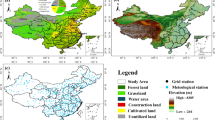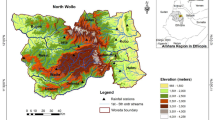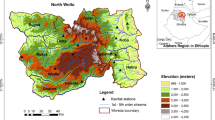Abstract
This article investigates whether the Moderate Resolution Imaging Spectroradiometer (MODIS)-derived global terrestrial Drought Severity Index (DSI) had the capability of detecting regional drought over subtropical southwestern China. Monthly, remotely sensed DSI data with 0.05° spatial resolution were used to characterize the extent, duration, and severity of drought from 2000 to 2010. We reported that southwestern China suffered from incipient to extreme droughts from November 2009 to March 2010 (referred to as the “drought period”). The area affected by drought occupied approximately 74 % of the total area of the study region, in which a moderate drought, severe drought, and an extreme drought accounted for 20, 12.7, and 13.2 % of the total area, respectively; particularly in March 2010, droughts of severe and extreme intensity covered the largest areas of drought, which were 16.1 and 18.6 %, respectively. Spatially, eastern Yunnan, western Guizhou, and Guangxi suffered from persistent droughts whose intensities ranged from mild to extreme during the drought period. Pearson’s correlation analyses were performed between DSI and the in situ meteorological station-based Standardized Precipitation Index (SPI) for validating the monitoring results of the DSI. The results showed that the DSI corresponded favorably with the time scales of the SPI; meanwhile, the DSI showed its highest correlation (mean: r = 0.58) with a three-month SPI. Furthermore, similar spatial patterns and temporal variations were found between the DSI and the three-month SPI, as well as the agro-meteorological drought observation data, when monitoring drought. Our analysis suggests that the DSI can be used for near-real-time drought monitoring with fine resolution across subtropical southwestern China, or other similar regions, based solely on MODIS-derived evapotranspiration/potential evapotranspiration and Normalized Difference Vegetation Index data.








Similar content being viewed by others
References
Brown J, Wardlow B, Tadesse T, Hayes M, Reed B (2008) The Vegetation Drought Response Index (VegDRI): a new integrated approach for monitoring drought stress in vegetation. GIScience Remote Sens 45(1):16–46
Caccamo G, Chisholm LA, Bradstock RA, Puotinen ML (2011) Assessing the sensitivity of MODIS to monitor drought in high biomass ecosystems. Remote Sens Environ 115(10):2626–2639
Chen M, Xie P, Janowiak JE, Arkin PA (2002) Global land precipitation: a 50-yr monthly analysis based on gauge observations. J Hydrometeorol 3(3):249–266
Gibbs WJ, Maher JV (1967) Rainfall deciles as drought indicators. Aust Bureau Meteorol Bull 48:37
Guttman NB (1999) Accepting the standardized precipitation index: a calculation algorithm. J Am Water Resour As 35(2):311–322
Huang RH, Cai RS, Chen JL, Zhou LT (2006) Interdecaldal variations of drought and flooding disasters in China and their association with the East Asian Climate System [in Chinese]. Chin J Atmos Sci 30(5):730–743
Kanamitsu M, Ebisuzaki W, Woollen J, Yang SK, Hnilo JJ, Fiorino M, Potter GL (2002) NCEP–DOE AMIP-II reanalysis (R-2). Bull Am Meteorol Soc 83(11):1631–1643
Kogan FN (1995a) Drought of the late 1980s in the United States as derived from NOAA polar-orbiting satellite data. Bull Am Meteorol Soc 76(5):655–668
Kogan FN (1995b) Application of vegetation index and brightness temperature for drought detection. Adv Space Res 15(11):91–100
Kogan FN (1997) Global drought watch from space. Bull Am Meteorol Soc 78(4):621–636
Kogan FN (2002) World droughts from AVHRR-based vegetation health indices. EOS Trans Am Geophys Union 83(48):557–564
Kogan FN, Adamenko T, Guo W (2013) Global and regional drought dynamics in the climate warming era. Remote Sens Lett 4(4):364–372
Li QZ, Yan NN, Zhang FF, Chang S, Wu BF (2010) Drought monitoring and its impacts assessment in southwest China using remote sensing in the spring of 2010 [in Chinese]. Acta Geogr Sinica 65(7):771–780
Liu J, Tan X, Wan J, Ma J, Zhang N (2011) Comparative analysis between the 2010 severe drought in southwest China and typical drought disasters [in Chinese]. China Water Resourc 9:17–20
Mckee TB, Doesken NJ, Kliest J (1993) The relationship of drought frequency and duration to time scales. In: Proceedings of the 8th conference on applied climatology, 17–22 January, Anaheim, CA (Boston: American Meteorological Society), pp 179–184
Mckee TB, Doesken NJ, Kliest J (1995) Drought monitoring with multiple time scales. In: Proceedings of the 9th conference on applied climatology, 15–20, January, Dallas, TX (Boston: American Meteorological Society), pp 233–236
McVicar TR, Jupp DB (1998) The current and potential operational uses of remote sensing to aid decisions on Drought Exceptional Circumstances in Australia: a review. Agric Syst 57(3):399–468
Mishra AK, Singh VP (2010) A review of drought concepts. J Hydrol 391:202–216
Mu QZ, Heinsch FA, Zhao MS, Running SW (2007) Development of a global evapotranspiration algorithm based on MODIS and global meteorology data. Remote Sens Environ 111(4):519–536
Mu QZ, Zhao MS, Running SW (2011) Improvements to a MODIS global terrestrial evapotranspiration algorithm. Remote Sens Environ 115(8):1781–1800
Mu QZ, Zhao MS, Kimball JS, Mcdowell JS, Running SW (2013) A remotely sensed global terrestrial drought severity index. Bull Am Meteorol Soc 94(1):83–98
Palmer WC (1965) Meteorological drought. Research Paper No. 45. US Department of Commerce Weather Bureau, Washington
Rouault M, Richard Y (2003) Intensity and spatial extension of drought in South Africa at different time scales. Water SA 29(4):489–500
Sandholt I, Rasmussen K, Andersen J (2002) A simple integration of the surface temperature/vegetation index space for assessment of surface moisture status. Remote Sens Environ 79:213–224
Shakya N, Yamaguchi Y (2010) Vegetation, water and thermal stress index for study of drought in Nepal and central northeastern India. Int J Remote Sens 31(4):903–912
Song LC, Deng ZL, Dong AX (2003) Drought. China Meteorological Press, Beijing
Suo MQ, Ding YH, Wang ZY (2008) Relationship between rossby wave propagation in southern branch of westerlies and the formation of the Southern Branch Trough in wintertime. J Appl Meteorol 19(6):731–740
Trenberth KE, Dai A, van der SG, Jones PD, Barichivich J, Briffa KR, Sheffield J (2014) Global warming and changes in drought. Nature Clim Change 4(1):17–22
Wang L, Chen W, Zhou W, Chan J, Barriopedro D, Huang RH (2010) Effect of the climate shift around mid 1970s on the relationship between wintertime Ural blocking circulation and East Asian climate. Int J Climatol 30(1):153–158
Wilhite DA, Glantz MH (1985) Understanding the drought phenomenon: the role of definitions. Water Int 10(3):111–120
Yang J, Gong DY, Wang WS, Hu M, Mao R (2012) Extreme drought event of 2009/2010 over southwestern China. Meteorol Atmos Phys 115(3/4):173–184
Zhang AZ, Jia GS (2013) Monitoring meteorological drought in semiarid regions using multi-sensor microwave remote sensing data. Remote Sens Environ 134:12–23
Zhang L, Xiao JF, Li J, Wang K, Lei LP, Guo HD (2012) The 2010 spring drought reduced primary productivity in southwestern China. Environ Res Lett 7(4):045706. doi:10.1088/1748-9326/7/4/045706
Zhao MS, Running SW (2010) Drought-induced reduction in global terrestrial net primary production from 2000 through 2009. Science 329(5994):940–943
Acknowledgments
This study is financially supported by the China Scholarship Council (CSC). We thank the Numerical Terradynamical Simulation Group (NTSG) at the University of Montana for providing MODIS Global Terrestrial DSI data. We also thank the National Drought Mitigation Center (NDMC) at the University of Nebraska-Lincoln for providing the program to calculate the SPI. Thanks are given to the Chinese Meteorological Data Service of China Meteorological Administration for sharing the meteorological data and drought observation data.
Author information
Authors and Affiliations
Corresponding author
Rights and permissions
About this article
Cite this article
Zhang, X.Q., Yamaguchi, Y. Characterization and evaluation of MODIS-derived Drought Severity Index (DSI) for monitoring the 2009/2010 drought over southwestern China. Nat Hazards 74, 2129–2145 (2014). https://doi.org/10.1007/s11069-014-1278-1
Received:
Accepted:
Published:
Issue Date:
DOI: https://doi.org/10.1007/s11069-014-1278-1




